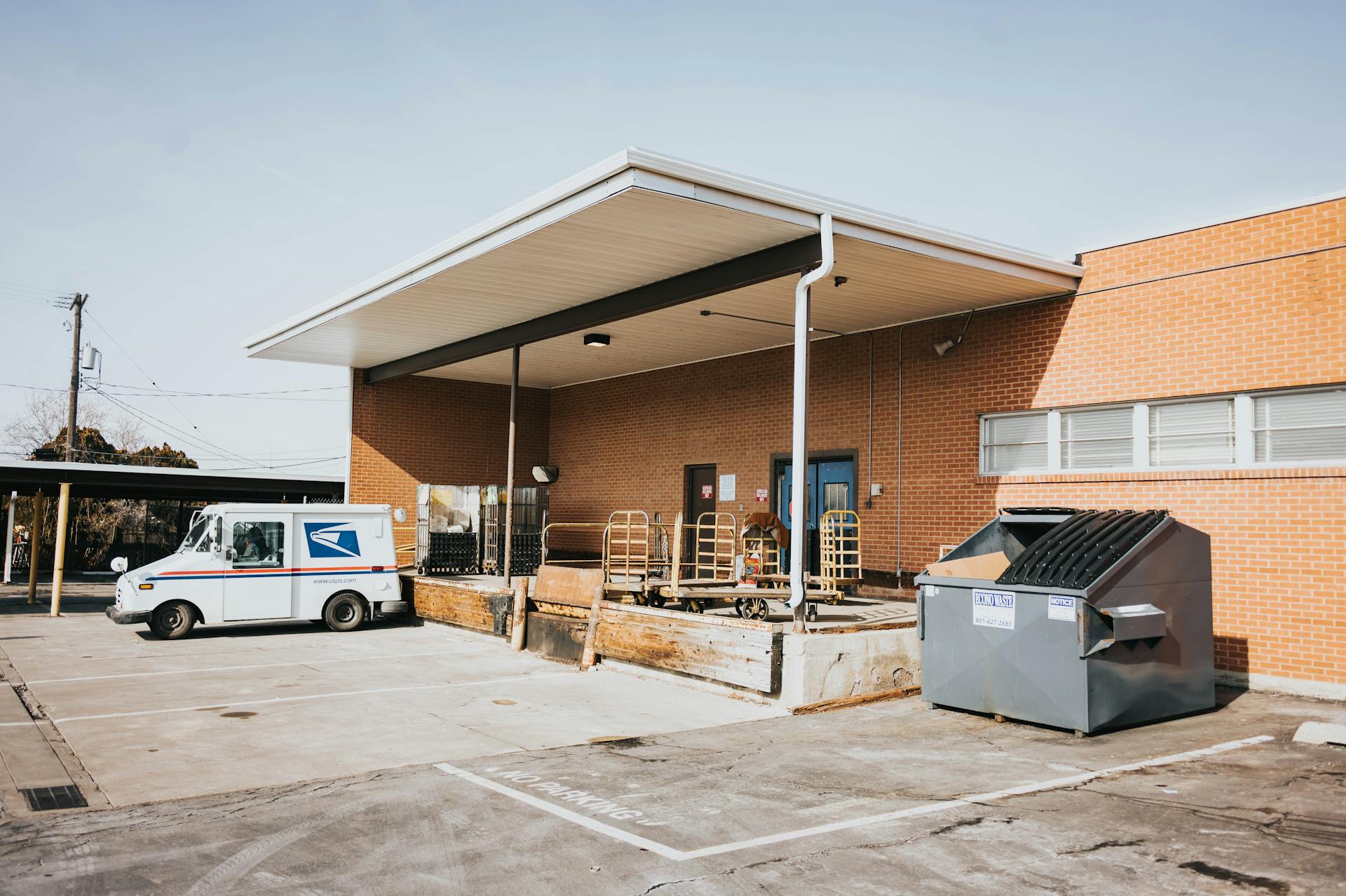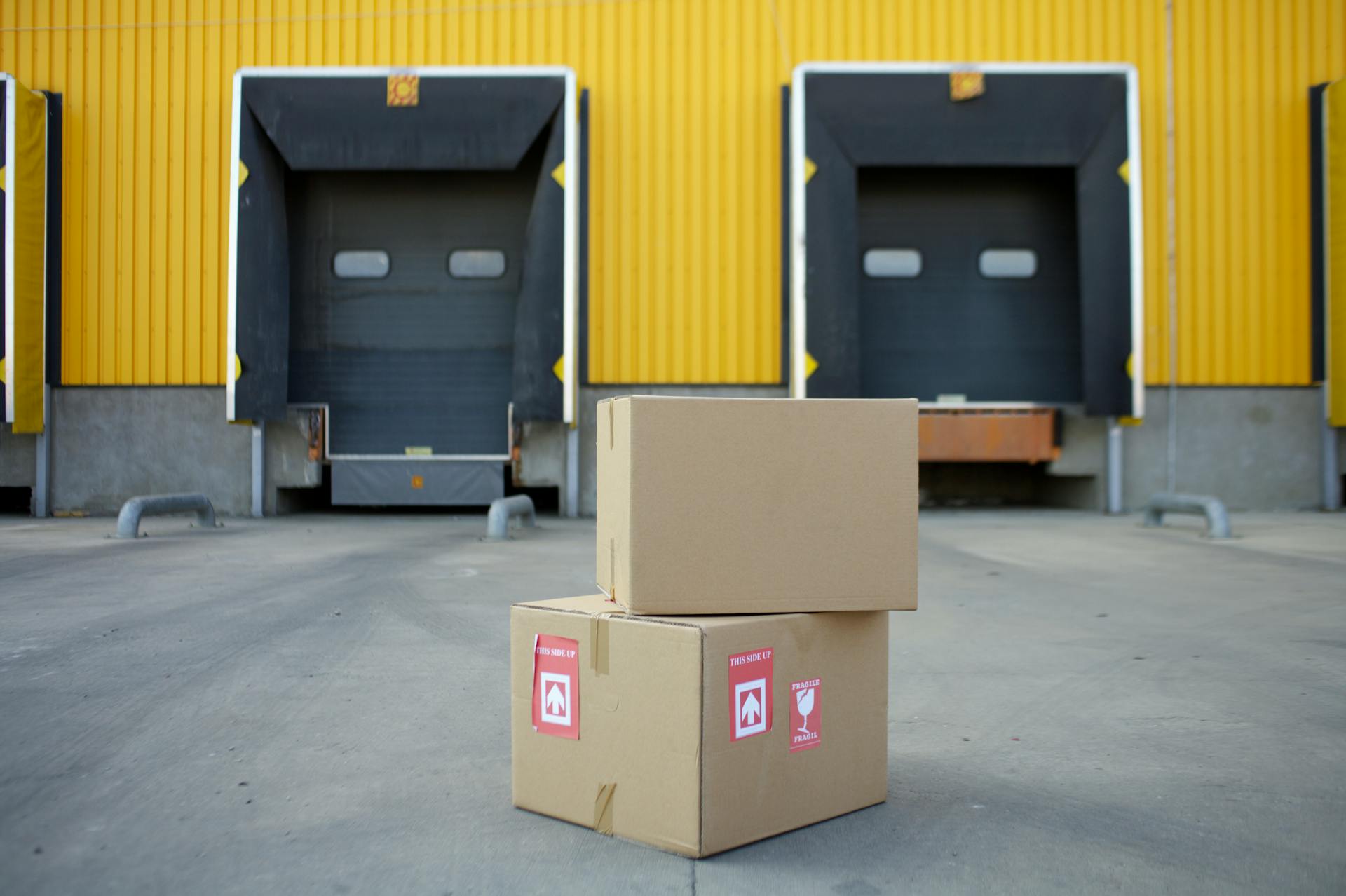
A loading bay dock is a critical component of any warehouse or logistics operation, and understanding the basics and best practices can make all the difference in keeping your operations running smoothly.
A loading bay dock typically consists of a platform, a dock leveler, and a pit or lip that allows trucks to drive up and load or unload cargo. The platform is usually made of steel or concrete and is designed to support the weight of the trucks and cargo.
To ensure safe and efficient operations, it's essential to follow best practices when using a loading bay dock. This includes regularly inspecting the dock and its components, such as the dock leveler and pit or lip, to ensure they are in good working condition.
Proper maintenance of the dock and its components can help prevent accidents and costly repairs.
For more insights, see: Fleet of Semi Trucks
Basics
A loading bay dock is a crucial part of any warehouse or industrial facility, and understanding its basics is essential for efficient material handling. A loading bay dock typically includes a dock leveler, which is a height-adjustable platform used as a bridge between the dock and the truck.
Related reading: B Pallets
The most common dock height in North America is 48-52 inches (120-130 cm), though heights of up to 55 inches (140 cm) occur as well. This height is designed to accommodate most trucks.
Bumpers are also a common feature of loading bay docks, protecting the dock from truck damage and serving as a guide for the truck driver when backing up.
Dock levelers can be operated via mechanical, hydraulic, or air-powered systems, providing flexibility and ease of use. Dock lifts, on the other hand, operate similar to a scissor lift to allow for greater height adjustments.
Here's a list of common loading bay dock features:
- Bumpers
- Dock leveler
- Dock lift
- Dock seals or dock shelters
- Truck or vehicle restraint system
- Dock light
- Indicator lights
- Loading dock software
- Side shift
Safety and Security
Safety and Security is a top priority when it comes to loading bay docks. Monitoring Ingress and Egress is crucial, and a dock manager's room or booth should be located so the manager can keep the entire dock area in view.
Security cameras can serve as a backup to ensure the safety of the dock area. Emergency Egress routes from the building should not be obstructed by loading docks or staging areas.
Here's an interesting read: Loading Dock Safety Lights

Proper examination of deliveries should take place in the staging area, and shipping and receiving logs should be kept. This helps to prevent any potential security threats.
A risk analysis for the building should be conducted to determine the best location for the loading dock, taking into account blast protection and potential threats. Utility rooms, utility mains, and service entrances should be separated from the loading dock by at least 50 feet.
Proper maintenance of the loading dock area is necessary to prevent slips and falls. This includes cleaning up spills and leaks immediately, repairing damaged flooring, and properly placing dock plates.
To prevent accidents, pedestrian and forklift routes should be differentiated and marked. Forklifts should be equipped with front and back lights and a horn, and mats or a drying agent should be used to prevent slippage on truck beds.
Here are some key safety measures to consider:
- Use chocks, wheel stops, or a hook on the rear axle of the truck to prevent runaway trucks.
- Ensure that drivers are adequately trained on the safe system of work they are expected to follow.
- Consider providing separate HVAC systems for loading docks when there is a significant risk of threatening, internal events.
The health of the forklift driver should also be considered, as they can be exposed to gas fumes from larger vehicles.
Components and Design
A loading bay dock is made up of several key components, each playing a crucial role in ensuring safe and efficient loading and unloading of goods. The dock leveler is a vital piece of equipment that bridges the gap between the building and the transport vehicle.
The dock leveler itself has several common components, including the dock, dock pit, shim, frame, deck, lip, toe guard, activation system, and bumpers. These components work together to provide a safe and stable surface for forklifts and other vehicles to move between the building and the transport vehicle.
Here are some key components to consider when designing a loading bay dock:
- Roadway approach: Design your roadway approach so that vehicles can drive in rather than have to back in.
- Yard approach: Plan your yard approach to allow for counter-clockwise traffic.
- Apron space: Ensure each vehicle has enough space to maneuver by planning the apron space around trailer movement.
- Landing strip: Position a concrete landing strip at each dock to reinforce the parking area and prevent damage to the vehicle.
By considering these components and design factors, you can create a safe and efficient loading bay dock that meets the needs of your business.
Components
A loading dock is made up of several key components that work together to ensure safe and efficient loading and unloading of goods. The dock itself is the area where loading and unloading takes place, and it's crucial to design it with safety in mind.

The dock pit is a recessed opening in the building's floor that accommodates the pit-style dock leveler. It's typically lined with reinforcing steel angles embedded in concrete to provide a sturdy base.
Shims are steel plates used to help level pit-mounted dock levelers. They're placed under the frame structure and welded in place to provide a structural load path to the foundation of the building.
The frame of a dock leveler is its supporting structure, and it's essential to choose the right size and type for your specific needs. A dock leveler's deck assembly is its most visible part, and it's typically made of an anti-skid surface such as a tread plate to provide traction at various working angles.
The lip assembly is pivotally attached to the deck assembly and is used to bridge the gap between the dock and the transport vehicle. It's often stored when not in use or used as a barrier protection for industrial vehicles.
A toe guard is a protective shield mounted flush to the side of a dock assembly to prevent toe and foot injuries while the dock leveler is in use. Activation systems provide the motive power for dock levelers, and they can be mechanical, pneumatic, or hydraulic, depending on the type of leveler.
Take a look at this: Loading Dock Leveler Installation

Bumpers are used to prevent transport vehicles from contacting and damaging the exterior of the building, dock leveler, or vehicle restraint. They're commonly made of rubber and come in various sizes and projections.
Here's a list of common components found in loading docks:
- Dock: The area where loading and unloading takes place
- Dock pit: A recessed opening in the building's floor that accommodates the pit-style dock leveler
- Shim: Steel plates used to help level pit-mounted dock levelers
- Frame: The supporting structure of a dock leveler
- Deck: The most visible part of a dock leveler, typically made of an anti-skid surface
- Lip: The part of the dock leveler that bridges the gap between the dock and the transport vehicle
- Toe guard: A protective shield mounted flush to the side of a dock assembly
- Activation system: Provides the motive power for dock levelers
- Bumper: Used to prevent transport vehicles from contacting and damaging the exterior of the building
Flush
Flush docks are designed to fit perfectly within your loading zone, featuring large, individual entryways that allow trucks to seamlessly attach for loading.
They often come with shock-absorbing bumpers to prevent structural damage to the facility.
Sawtooth
Sawtooth loading docks can be a great space-saving solution for large-scale manufacturing operations or warehouses with ample storage space.
These docks are designed with several smaller docks at an angle, allowing you to load more vehicles at a time and simplify your roadway and yard approaches.
The angled layout of sawtooth docks can, however, limit the indoor space of your facility if not properly planned.
You must be mindful of the space available to ensure a convenient loading dock layout.
Sawtooth docks are typically used in large-scale manufacturing operations or by warehouses with ample storage space.
A fresh viewpoint: Storage Unit with Loading Dock
Truck Bay Widths

When designing a loading dock, the width of the truck bay is a crucial factor to consider. A minimum of 12 ft wide truck bay is recommended to provide enough space for trailers to back squarely to the dock.
The width of the truck bay should be at least 12 ft to accommodate trailers that are 8’0″ to 8’6″ wide. Designing 14 ft wide bays can help reduce congestion and provide a staging area between the docks.
The maximum trailer size limits are 8’6″ wide x 13’6″ high, but with a special permit, a flatbed may exceed the maximum width.
Here are some general guidelines for truck bay widths:
A wider truck bay can provide ease of traffic and avoid bottlenecks, making the loading dock operation safer and more efficient. The width of the truck bay should be determined by the number of trucks received per day, delivery schedule, and the number of pallets safely unloaded/loaded per hour.
Expand your knowledge: Air Freight Cost per Kg
Space and Layout
Loading docks are utilitarian spaces that should be designed for function and durability. They need to accommodate large vehicles, forklifts, and pedestrian traffic.
Safety and security are also top priorities in loading dock design. This involves ensuring the space is safe for users and nearby spaces.
A well-designed loading dock space should be able to handle the flow of goods and people efficiently, minimizing congestion and delays.
4. Depressed
Depressed loading docks have a sloped driveway, which can be tricky to navigate. The decline angle should not exceed 10% to avoid accidents.
Snow, rain, and other hazards can make it difficult for trucks to operate on a decline. This is because they can experience traction problems.
Be sure to design a loading area that minimizes the risk of damage while vehicles maneuver the dock.
5. Open
Open loading docks are an option for businesses, but they come with their own set of challenges. They're typically used outdoors and feature an overhead canopy, leaving the rest of the dock exposed.

An open loading dock can be a flexible workspace, allowing your staff to move freely and work as they see fit, saving valuable time. This is due to the lack of walls or barriers that restrict movement.
However, open loading docks are also prone to vandalism, theft, and minimal security. They can't be heated or cooled efficiently, posing a risk to temperature-sensitive products and creating uncomfortable working conditions for employees.
A major drawback of open loading docks is their vulnerability to the elements. They can be affected by flooding, freezing, strong winds, and other hazards, creating an unsafe working environment and damaging goods. To mitigate this risk, the truck's approach to the dock should be at grade or sloped away from the loading dock to prevent the collection of storm water near the dock.
Here are some key differences between open loading docks and other types of docks:
Overall, while open loading docks offer some flexibility and organization, their disadvantages make them less desirable than other types of docks.
Explore further: Dock Bumpers for Loading Docks
Space Attributes

Loading docks are utilitarian spaces designed for function and durability, but also for safety and security. They must accommodate large vehicles, forklifts, and pedestrian traffic.
The size and layout of loading docks can vary depending on the type of business and the volume of goods being transported. Space must be allocated for equipment and storage.
Large vehicles and forklifts require designated areas for loading and unloading, which can impact the overall layout of the space. This can also affect the flow of pedestrian traffic.
The design of loading docks should prioritize functionality and safety, with features such as designated traffic lanes and adequate lighting. This helps prevent accidents and ensures efficient operations.
Explore further: Loading Dock Barriers
Warehouse
A well-designed warehouse is crucial for efficient operations, and that starts with the layout.
The type of loading dock you choose should fit your warehouse concept, as different types of docks have their own advantages and disadvantages.
A variety of warehouse roles and responsibilities exist, making it essential to hire the right staff for your warehouse.
Determine Door Sizes

Space your doors 12 ft apart to accommodate most trucks, sealing systems, and communication light systems. This allows for efficient use of space and easy access for loading and unloading.
Keep doors as small as possible – usually narrower than 8 ft – in temperature-controlled docks, where energy is lost through doors. This helps minimize energy loss and optimize temperature control.
9 ft wide doors are ideal for servicing 8’6″ wide trailers, as they simplify side-by-side palletizing and reduce the potential for product damage. This is a great option for operations that require frequent loading and unloading of trailers.
Wider doors, such as 10 ft wide doors, are designed for oversized loads and can provide full access to the entire width and height of a full-size trailer. However, they require more building space, which may not be available in all facilities.
8 ft high doors can accommodate many loading and unloading operations, but may not be suitable for floor-to-ceiling loading. This can lead to higher freight costs due to inefficient use of trailer space.
A 9 ft high door allows for improved floor-to-ceiling loading, making for better space utilization and a decreased risk of product damage due to door impact. This is a great option for operations that require frequent loading and unloading of trailers.
Suggestion: Wide Load vs Oversize Load
Accessible

A loading bay dock should be accessible to everyone, including those with disabilities. A ramp from the loading dock to the truck parking area is a must-have for deliveries from small trucks and vans.
The ramp should have a maximum slope of 1:12 to ensure it's easily maneuverable for deliveries on carts and dollies. This is in compliance with ADA Accessibility Guidelines.
For a smooth delivery process, consider the following:
- Provide a ramp from the loading dock to the truck parking area with a maximum slope of 1:12.
- Ensure the ramp complies with ADA Accessibility Guidelines.
Equipment and Installation
To set up a loading bay dock, you'll need to choose the right equipment. The most common type of dock is a hydraulic dock, which can lift the dock to different heights to accommodate various truck sizes.
A hydraulic dock typically requires a pit to be dug for the hydraulic cylinders, which can be a significant investment.
The size of the dock will depend on the size of the trucks you'll be receiving. A standard dock is around 40 feet long, but can be customized to fit your specific needs.
For example, if you're expecting large semi-trucks, you'll need a dock that's at least 45 feet long.
The dock's surface should be made of a durable material, such as steel or concrete, to withstand heavy use. A steel dock is a popular choice because it's easy to install and maintain.
The dock's height should also be considered, as it will need to match the height of the trucks you'll be receiving. A standard dock height is around 48 inches, but can be adjusted to fit your needs.
A dock leveler is a must-have for any loading bay dock, as it allows trucks to drive up to the dock and unload cargo easily. A dock leveler can be either mechanical or pneumatic, and should be chosen based on the type of trucks you'll be receiving.
Take a look at this: Electric Drayage Trucks
Seal and Shelter
Enclosed loading docks offer advanced security and weather protection, but you'll need to consider space, ventilation, and layout when building your own.
Space is crucial, so ensure you have enough room for vehicles to park and maneuver, as well as space for forklifts and other equipment to move without obstructions.
A functional ventilation system is necessary to keep you and your employees safe from exhaust fumes.
Enclosed

Enclosed docks are a great option for companies that need to protect their goods from the elements. They're essentially a garage-like environment where vehicles can park.
Space is a key consideration when building an enclosed dock. You'll need enough room for vehicles to park and maneuver, as well as space for forklifts and other equipment to move around without obstacles.
A good ventilation system is crucial in an enclosed dock. This is because vehicles and motorized equipment will give off exhaust, and you'll need to ensure the air is safe for your employees to breathe.
A simple and organized layout is essential in an enclosed dock. This makes it easier for employees to find what they need, especially when multiple vehicles are parked at once.
Here are some key things to keep in mind when designing an enclosed dock:
- Space: Make sure you have enough room for vehicles and equipment to move around.
- Ventilation: Install a functional ventilation system to keep the air safe.
- Layout: Keep the space simple and organized for easy navigation.
Find Right Seal/Shelter
Finding the right seal or shelter for your dock can be a daunting task, but it's essential to get it right. At Chalfant, finding the right dock enclosure for your application just got easier.
There are several types of seals and shelters to choose from, including dock seals, hybrid dock seals, flexible dock shelters, rigid dock shelters, and rail shelters.
A dock seal is a great option for protecting your dock from the elements, while a hybrid dock seal offers a combination of features. Flexible dock shelters are designed to provide a secure seal, and rigid dock shelters offer a more permanent solution.
Rail shelters are perfect for protecting your dock's railings from damage.
Curious to learn more? Check out: Loading Dock Door Seals
Relevant Codes
When designing a loading bay dock, it's essential to consider the relevant codes and standards. The GSA PBS-P100 Facilities Standards for the Public Buildings Service, for example, outlines minimum requirements for facilities.
These codes and standards are not just a checklist, but a guide to ensure safety and functionality. Architects, engineers, and consultants should consider exceeding the applicable requirements whenever possible.
The ICC IBC International Building Code is another crucial standard to consider. It provides a comprehensive framework for building design and construction.
Curious to learn more? Check out: Amazon Pallets Requirements
Some of the key agencies and organizations that have developed codes and standards affecting the design of loading docks include:
- GSA PBS-P100 Facilities Standards for the Public Buildings Service
- ICC IBC International Building Code
By understanding and following these codes and standards, you can create a loading bay dock that is not only functional but also safe and compliant with regulations.
Products and Interior
A loading bay dock's products and interior are designed to optimize efficiency and safety.
The dock leveler is a crucial component, typically made of durable steel or aluminum, and can be either mechanical or hydraulic in operation.
A well-designed dock seal or shelter can reduce heat loss and prevent weather-related damage to the dock and surrounding areas.
The interior of a loading bay dock often includes LED lighting to improve visibility and reduce energy consumption.
A loading dock's interior can also feature a pit or a raised platform, depending on the specific application and requirements.
A well-maintained dock can also include a pit or a raised platform, depending on the specific application and requirements.
Broaden your view: Loading Dock Platform
The interior of a loading bay dock is designed to be durable and easy to clean, with surfaces often made of materials like stainless steel or epoxy-coated concrete.
LED lighting can also be used to create a safe and secure environment by illuminating the dock area and reducing shadows.
A loading bay dock's interior can also feature a variety of safety features, such as guardrails and warning signs, to prevent accidents and injuries.
Frequently Asked Questions
Is it loading dock or bay?
Loading docks are elevated platforms for direct truck access, while loading bays are broader areas with varying designs for different vehicle sizes.
What is the most common cause of injury at a loading dock?
The most common cause of injury at a loading dock is accidents involving heavy equipment and manual lifting, which can lead to serious back injuries and other hazards.
What is the height of a loading bay dock?
The standard height of a loading bay dock is typically 1250 mm, suitable for most warehouses and trailer parks. However, some trucks with hydraulic tailboards may require a letter box space under the dock leveller.
Featured Images: pexels.com


